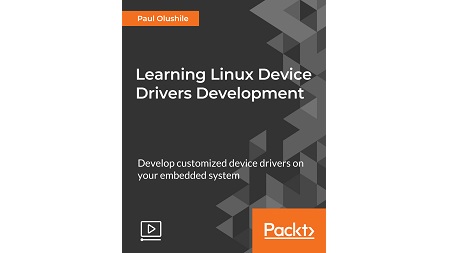
English | MP4 | AVC 1920×1080 | AAC 48KHz 2ch | 1h 36m | 359 MB
Develop customized device drivers and implement them in your embedded Linux system
Linux is an operating system that consists of a monolithic kernel. This course will get you comfortable with setting up and building any device driver from scratch.
This course covers driver installation and shows you how to configure server management and resolve issues with synchronization, concurrency, power management and more. You’ll see how to create and manage your own driver within Linux and have a better experience using the Linux terminal.
You’ll set up and configure your Ubuntu machine to develop drivers catered to audio and TPM drivers for Ubuntu. You’ll also learn to push your live drivers to import them into the core components of the OS.
Finally, you’ll learn to manage memory on your system in the most efficient way by focusing on many different techniques.
This course provides you with a step-by-step setup of your new Linux server. Here, we will go ahead by graphics driver and kernel drivers components. With this, you’ll configure the server and the issues to do with synchronization and power management.
What You Will Learn
- Develop drivers for widely used I2C and SPI devices and use the regmap API
- Use kernel facilities to develop powerful drivers
- Create and use graphics drivers
- Setup and use your Ubuntu machine
- Push or snap your drivers to make them live
- Discover and use advanced IRQ within your driver development
- Set up your network and connection drivers
- Develop a graphics driver with the power of C programming language
- Prepare and set up Ubuntu for driver developments and installation testing
Table of Contents
C Language
1 The Course Overview
2 Talking about the C Language
3 Finding a Compiler
4 Writing Our First Program
5 Testing the Program We Wrote
6 Finishing with Basic C Language
Graphic Driver Development
7 Talking about Graphic Drivers
8 Binding Your Driver to the Graphics Framework
9 Address Spaces and Creating Rules
10 Calling Sequence
11 Conventions
Ubuntu Developers’ Tools
12 Update and Upgrade
13 Standard Developer Tools
14 Installing VBox Utilities
15 Install Latest Snap
16 Getting Pulse Audio
17 Virtualenvwrapper Installation
Kernel Driver Development
18 Prepare Your System for Building LKMs
19 Install and Configure Git
20 The Module Code
21 Coding the Module
22 Compiling and Testing
Community Contributors
23 Create Linux Account
24 Become a Guest Contributor
25 AskAnswer Questions
26 Stay Active in Forums
27 Compiling and Testing
Networking Drivers
28 Find and Create Network Drivers
29 Become More Experienced with Setup
30 Testing Network Config
31 Testing Overall Connection
32 Saving the Best Config
Memory Management
33 Advanced IRQ
34 Multi-Threaded Code
35 Embedded Memory on Linux
36 Management Techniques
Resolve the captcha to access the links!